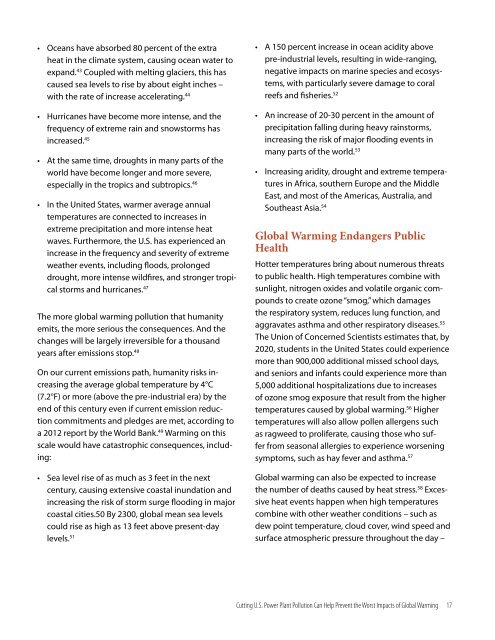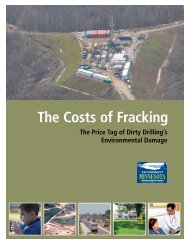America’s Dirtiest Power Plants
America's Dirtiest Power Plants - Environment Minnesota
America's Dirtiest Power Plants - Environment Minnesota
- No tags were found...
You also want an ePaper? Increase the reach of your titles
YUMPU automatically turns print PDFs into web optimized ePapers that Google loves.
Oceans have absorbed 80 percent of the extra<br />
heat in the climate system, causing ocean water to<br />
expand. 43 Coupled with melting glaciers, this has<br />
caused sea levels to rise by about eight inches –<br />
with the rate of increase accelerating. 44<br />
Hurricanes have become more intense, and the<br />
frequency of extreme rain and snowstorms has<br />
increased. 45<br />
At the same time, droughts in many parts of the<br />
world have become longer and more severe,<br />
especially in the tropics and subtropics. 46<br />
In the United States, warmer average annual<br />
temperatures are connected to increases in<br />
extreme precipitation and more intense heat<br />
waves. Furthermore, the U.S. has experienced an<br />
increase in the frequency and severity of extreme<br />
weather events, including floods, prolonged<br />
drought, more intense wildfires, and stronger tropical<br />
storms and hurricanes. 47<br />
The more global warming pollution that humanity<br />
emits, the more serious the consequences. And the<br />
changes will be largely irreversible for a thousand<br />
years after emissions stop. 48<br />
On our current emissions path, humanity risks increasing<br />
the average global temperature by 4°C<br />
(7.2°F) or more (above the pre-industrial era) by the<br />
end of this century even if current emission reduction<br />
commitments and pledges are met, according to<br />
a 2012 report by the World Bank. 49 Warming on this<br />
scale would have catastrophic consequences, including:<br />
Sea level rise of as much as 3 feet in the next<br />
century, causing extensive coastal inundation and<br />
increasing the risk of storm surge flooding in major<br />
coastal cities.50 By 2300, global mean sea levels<br />
could rise as high as 13 feet above present-day<br />
levels. 51<br />
A 150 percent increase in ocean acidity above<br />
pre-industrial levels, resulting in wide-ranging,<br />
negative impacts on marine species and ecosystems,<br />
with particularly severe damage to coral<br />
reefs and fisheries. 52<br />
An increase of 20-30 percent in the amount of<br />
precipitation falling during heavy rainstorms,<br />
increasing the risk of major flooding events in<br />
many parts of the world. 53<br />
Increasing aridity, drought and extreme temperatures<br />
in Africa, southern Europe and the Middle<br />
East, and most of the Americas, Australia, and<br />
Southeast Asia. 54<br />
Global Warming Endangers Public<br />
Health<br />
Hotter temperatures bring about numerous threats<br />
to public health. High temperatures combine with<br />
sunlight, nitrogen oxides and volatile organic compounds<br />
to create ozone “smog,” which damages<br />
the respiratory system, reduces lung function, and<br />
aggravates asthma and other respiratory diseases. 55<br />
The Union of Concerned Scientists estimates that, by<br />
2020, students in the United States could experience<br />
more than 900,000 additional missed school days,<br />
and seniors and infants could experience more than<br />
5,000 additional hospitalizations due to increases<br />
of ozone smog exposure that result from the higher<br />
temperatures caused by global warming. 56 Higher<br />
temperatures will also allow pollen allergens such<br />
as ragweed to proliferate, causing those who suffer<br />
from seasonal allergies to experience worsening<br />
symptoms, such as hay fever and asthma. 57<br />
Global warming can also be expected to increase<br />
the number of deaths caused by heat stress. 58 Excessive<br />
heat events happen when high temperatures<br />
combine with other weather conditions – such as<br />
dew point temperature, cloud cover, wind speed and<br />
surface atmospheric pressure throughout the day –<br />
Cutting U.S. <strong>Power</strong> Plant Pollution Can Help Prevent the Worst Impacts of Global Warming 17



